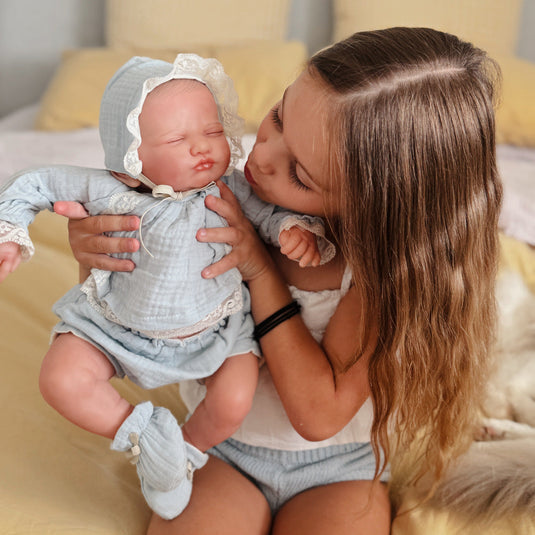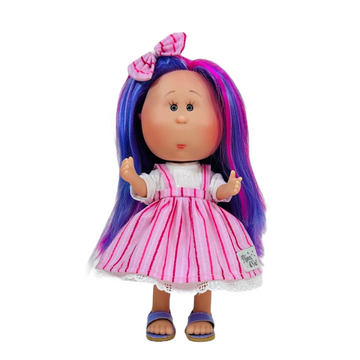An Unbiased View of Dolls And Accessories
Table of ContentsThe Dolls And Accessories DiariesGetting My Dolls And Accessories To WorkSome Of Dolls And AccessoriesDolls And Accessories - The Facts9 Simple Techniques For Dolls And AccessoriesSome Known Questions About Dolls And Accessories.The Ultimate Guide To Dolls And Accessories
When dolls are included in team play, kids practice waiting, sharing, and paying attention to others' concepts. Whether they're pretending to be a parent, sibling, or friend, kids discover exactly how connections workhow to support others, resolve differences, and look after another person. These very early role-play experiences end up being the foundation for healthy and balanced relationships and connections later on in life.Repeating calming routines with a doll (feeding, shaking, placing to bed) can assist kids really feel tranquil and secure. These soothing rituals show them exactly how to self-regulate. Looking after a doll can make a child really feel qualified and certain - european dolls. It provides a feeling of obligation and control in a globe that typically feels uncertain.
Dolls And Accessories Can Be Fun For Anyone
When kids see dolls that show their race, heritage, and society, it enhances a favorable feeling of identification. Dolls additionally present children to cultures outside their own, developing considerate interest and empathy for others.
As Dr. Karyn Purvis, a leader in child growth and trauma-informed care, as soon as said: This powerful quote highlights exactly how play isn't simply funit's exactly how kids find out best. The mind cables itself with repetition. When a child is engaged, happy, and psychologically attached to an activitylike doll playthe mind reinforces those connections quicker and extra meaningfully.
Facts About Dolls And Accessories Uncovered

Young boys need empathy, generosity, and creativity tooand doll play provides that. Yesdolls use something unique. They motivate open-ended narration and emotional link in a way few other toys do. Dolls are usually a child's very first "pal," aiding them exercise connections, build interaction abilities, and feel comforted. Children develop their sense of self from a young age.
The Single Strategy To Use For Dolls And Accessories
With dolls that matter. Samantha Ong Samantha Ong is the creator of Joeydolls, a Canadian-based toy brand name on a goal to commemorate Oriental societies with joyful, comprehensive play. Influenced by her own experiences growing up without cultural depiction, Samantha designs dolls that help youngsters feel proud of who they are while sparking curiosity and empathy in others.
Playing with dolls urges youngsters to talk more concerning others' thoughts and feelings, a research study has actually found. The study suggests that playing fictional games with dolls might assist youngsters establish social skills, theory of mind and empathy. The neuroscientist who led the job claimed that the academic value of having fun with Lego and construction playthings was extensively accepted, yet the benefits of having fun with dolls often appeared to have been ignored."When youngsters develop fictional globes and function have fun with dolls, they communicate at first aloud and after that internalise the message regarding others' ideas, feelings and feelings," claimed Dr Sarah Gerson, a neuroscientist at Cardiff University and the lead author.
Dolls And Accessories - The Facts
They were additionally more probable to address the dolls in the second individual, speaking to them straight, whereas the characters on the computer display they often tended to refer to in the 3rd individual. No distinction was observed between boys and women."Interior state language can show that a youngster is thinking of other individuals's ideas and feelings while having fun with dolls," said Gerson.
Which they see language usage hereof is excellent verification of the hypothesis."Mardell added that the findings should relate to any kind of type of role-play plaything, as opposed to being details to Barbies. "I would certainly take a broader sight of what a doll is," he said." [It could be] any type of item that the child can invest a sense of other into a stuffed animal, a stove glove that speaks with them, and even an imaginary pal."Children commonly start to reveal indications of internal state language around the age of four.
All about Dolls And Accessories
"It ends up being important for making and sustaining relationships, and just how they gain from their instructors, and moms and dads."The research study also discovered that the kids had actually boosted mind task in the posterior superior temporal sulcus (pSTS) region when they talked as though their dolls had ideas and sensations. The pSTS region is believed to be associated with the growth of social and emotional handling skills.
Childhood is not a static life phase; indeed, the meaning, meaning and understanding of childhood years are all subject to alteration. By the 19th century among the most profound modifications was the significance positioned on allowing youngsters to experience "the care free joys" of childhood with playtime tasks. Play was currently considered to be an important element of a good childhood.
In order to fully recognize the significance of play, one must additionally recognize the relevance of the doll. Nevertheless, dolls are much even more than playthings developed to entertain young ladies. During the 19th century appropriate playtime activities were picked to advertise intellectual, physical or emotional development. Dolls were especially popular since they were believed to promote and support womanly qualities such as compassion, caring and empathy.
The Greatest Guide To Dolls And Accessories

It is just with historical investigations that researchers can intend to discover and document the complete range of playtime experiences. Narrating these experiences, and especially the role of dolls, is crucial for offering a more complete image of youth throughout the nineteenth century. Alarcn, Sara E - european dolls., "Kid's Play: The Duty of Dolls in 19th Century Childhood Years" (2007 )